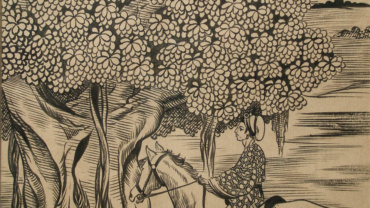
Asit Kumar Haldar
Asit Kumar Haldar
Brief info
"It is freedom when your spirit conjures up a vision from the inert, to illuminate its every line with the flame of your devotion. You have the magic of life's touch in your eyes and your dream has come out in a creation in which are made one, my form and your delight," said the Nobel Laureate, Rabindranath Tagore of the late Asit Kumar Haldar's sculptures.
For this versatile artist who belonged to the first generation of painters and sculptors from the Neo-Bengal School of Art, art was a medium through which he expressed himself, be it painting, sculpture or literature.
Haldar, a grand nephew of Rabindranath Tagore, was born in 1890 and showed his aptitude for painting at a very young age. One of his earliest paintings 'Arjuna Learning Archery from Dronacharya' not only bore testimony to his talent, but also demonstrated his leaning towards mythological subjects, an interest that he carried on into his adult years. The choice of myths and legends also lent itself naturally to his style of paintin: simple, lyrical and tinged with an amazing grace and beauty.
Educated at the Government School of Art in Calcutta under the able tutelage of his grand uncle Rabindranath Tagore, Haldar epitomized the qualities that went on to make the Bengal School of Art one of the most popular in the country. Haldar also picked up many of the tricks of his trade from folk painters and artistes like Jhareshwar Chakravarthi, Jadhunath Pal and Bakkeshwar Pal. To complete his education, Haldar studied sculpture with Leonard Jennings, the then government architect and sculptor.
Perhaps the most significant contribution came when he, along with some other artists, was commissioned by the Indian Society of London to copy the paintings in the Ajanta Caves. The technique of painting murals and narrating a tale with the brush were something a new experience. Enriched, Haldar incorporated these into his work to achieve a wonderful life-like effect and his canvases attracted worldwide attention.
Haldar worked with equal ease in oil, tempera, watercolors and a special technique that he developed called 'lacit'-lacquered painting on wood. His versatility became a byword, prompting Abindranath Tagore to say of his pupil, "Kshitindranath you have mastered in depicting 'Vaishnavite' themes, I have myself so far succeeded in Mughal subjects, Nandalal in classical episodes but Asit seems to have no limitations."
Drawing upon the rich cultural heritage of India, Haldar painted a whole series of 32 paintings based on the Buddha. Thirty canvases formed a collection of episodes from Indian history and he also illustrated Omar Khayyam's verses. His interpretations of the stories in the Mahabharata exhibited a strong spiritual bend and brought him to the notice of both the public and the critics.
Asit Kumar Haldar did not limit himself to the world of painting and sculpture. He was equally adept at composing songs, writing poetry, books and numerous essays for leading periodicals. 'Art and Tradition' and 'Our Heritage in Art", in English, 'Ajanta', 'Bharater Silpakatha', 'Bharater Karushipla', in Bengali and 'Rup Darshika' in Hindi were authored by this multi-faceted, multi-talented artist who achieved excellence in so many fields.


